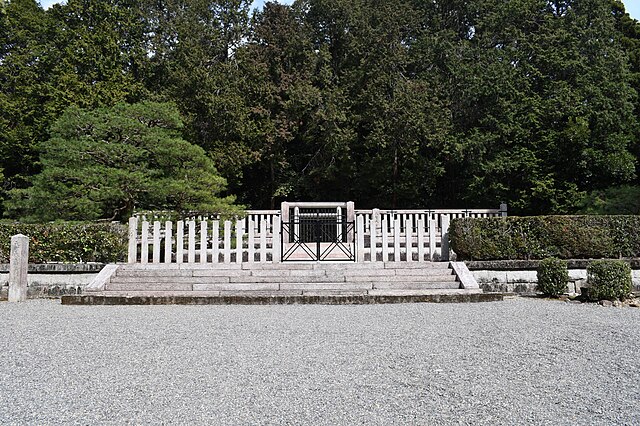Fujiwara no Kamatari, also known as Nakatomi no Kamatari , was a Japanese politician and aristocrat who, together with Prince Naka no Ōe, carried out the Taika Reform. He was the founder of the Fujiwara clan, the most powerful aristocratic family in Japan during the Nara and Heian periods. He, along with the Mononobe clan, was a supporter of Shinto and fought the introduction of Buddhism to Japan. The Soga clan, defenders of Buddhism in the Asuka period, defeated Kamatari and the Mononobe clan, and Buddhism became the dominant religion of the Imperial Court. Kamatari was appointed Inner Minister, and, along with Prince Naka no Ōe, later Emperor Tenji (626–672), launched the Taika Reform of 645, which centralized and strengthened the central government. Just before his death, he received the surname Fujiwara and the rank Taishōkan from Emperor Tenji, thus establishing the Fujiwara clan.
![Fujiwara no Kamatari with his sons Jo'e [ja] and Fujiwara no Fuhito, who is wearing court robes. (Nara National Museum)](https://upload.wikimedia.org/wikipedia/commons/thumb/f/f7/Fujiwara_Kamatari_with_Fuhito_and_J%C5%8De_%28Nara_National_Museum%29.jpg/234px-Fujiwara_Kamatari_with_Fuhito_and_J%C5%8De_%28Nara_National_Museum%29.jpg)
Fujiwara no Kamatari with his sons Jo'e [ja] and Fujiwara no Fuhito, who is wearing court robes. (Nara National Museum)
An illustration of Fujiwara no Kamatari by Kikuchi Yōsai
Emperor Tenji , known first as Prince Katsuragi and later as Prince Nakano Ōe until his accession, was the 38th emperor of Japan who reigned from 668 to 671. He was the son of Emperor Jomei and Empress Kōgyoku, and his children included Empress Jitō, Empress Genmei, and Emperor Kōbun.
Memorial Shinto shrine and Mausoleum of Emperor Tenji [ja]
Image: Gobyono Kofun, haisho 1

![Fujiwara no Kamatari with his sons Jo'e [ja] and Fujiwara no Fuhito, who is wearing court robes. (Nara National Museum)](https://upload.wikimedia.org/wikipedia/commons/thumb/f/f7/Fujiwara_Kamatari_with_Fuhito_and_J%C5%8De_%28Nara_National_Museum%29.jpg/234px-Fujiwara_Kamatari_with_Fuhito_and_J%C5%8De_%28Nara_National_Museum%29.jpg)

![Memorial Shinto shrine and Mausoleum of Emperor Tenji [ja]](https://upload.wikimedia.org/wikipedia/commons/thumb/b/bb/TenchiTennoRyo.jpg/640px-TenchiTennoRyo.jpg)
